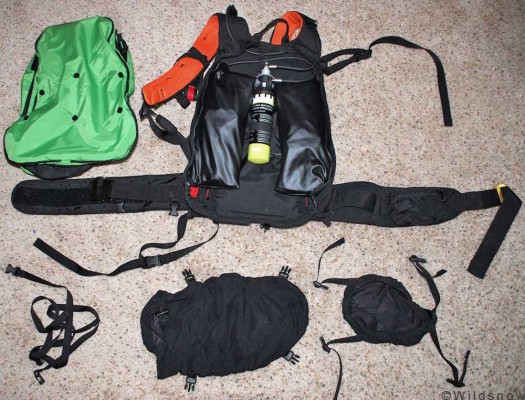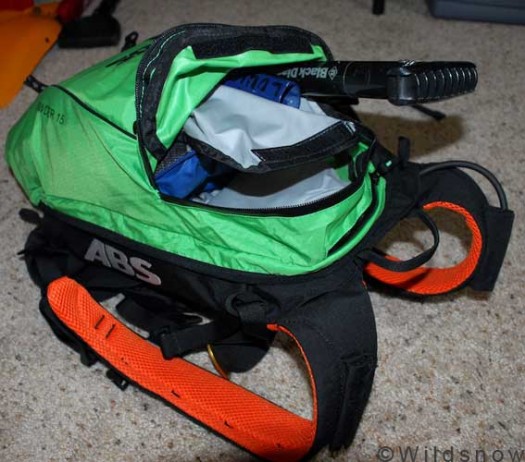Myself, Lou and a few other WildSnow associates have been testing the new ABS Powder 15 backpack which has just been released in the US. It is super light for an airbag pack (6.33 lbs) and is ideal for slackcountry days and perhaps short tours. Avalanche airbags save lives — that is proven — but the weight they add to your kit is discouraging. With only a few days skiing with the Powder 15, we are psyched to see how the ABS packs are evolving to get lighter and lighter (stay tuned for reviews of other, larger airbag packs).

Tyler carries his heavy weight skis to put the pack carry to the test.
Like other ABS packs, the Vario and Escape series, the Powder series uses a dual airbag system that is powered by a nitrogen cartridge (for more on how this works, see my airbag overview). Also, like the Vario series, it utilizes a “zip on” system where one can attach different sized bags to the frame of the pack (called the “base unit”). Currently, only 5 and 15 liter options exist. Improved features over the Vario line include a new airbag fabric made by Zodiac that is over 1/4 pound lighter (nice!), overall reduction of mass for lighter weight, lighter weight fabric, and an easier to use metal hipbelt buckle with a slot.

Top left is the green zip on bag. Notice the buttons which allow for customization of the internal straps. On the right is the base unit, with diagonal ski carry straps attached and dangling. Below are more straps, mesh pouch, and mesh helmet carrier. Click to enlarge.

Base unit showing cartridge and one of the air bags pulled out of it's sleeve. Note the new airbag fabric. Also, you can see the bomber attachment point to the pack. Click to enlarge
Powder 15 is a zippered panel style pack with interior sleeves intended to help separate avy tools and other items. Given the tiny 15 liter pack volume, I’m not sure any separation is really necessary, but some users may like having this, and parts of the partition system would be easy to remove to reduce weight. There is also a very small pocket on the top that will fit a couple snacks or extra straps. Again, this pack is super light by current airbag pack standards, weighing 6.33 lbs with the US steel cartridge. That’s 0.6 lbs lighter than the Vario 15 and over one and half pounds lighter than much of the competition. Throw a carbon cartridge in there (once the US Dept of Transportation approves it) and shave off a further 2/3 of a pound. We are very excited about all this, and ABS appears to be leading the way.

Front tool pocket separates from main compartment with velcro. An 18 1/2 inch shovel handle doesn't fit as shown. Put it in the main compartment, diagonally and it barely fits.

The rear tool pocket, which lies against the back. Organizer straps can be customized with buttons that fit into different slots. Again, too small for this small shovel handle. You could also put a drinking bladder in there, which will hang from an included velcro strap. Also note the small gray flap on the right, that's the mini accessory pocket, accessed from the exterior.
Unfortunately, for all these weight savings, you don’t get much in volume; 15 liters is too small for full day of backcountry ski touring with a normal kit. The included accessory pouch adds an extra 6 liters or so, but even then, you’ll feel cramped. On the other hand, Powder 15 is brilliant for anyone who drops out the gate at the ski area or does short front country laps at their local pass. If I still lived in Telluride (*cough*and the upper Bear Creek gates were still open *cough*), I’d bring this pack nearly every day. Another item worth mentioning is that the 15 has a much shorter back panel than the Vario or Escape series, which can make it awkward to carry heavy loads for taller people (I’m 6’0″). To transfer the load to your hips, you have to run the shoulder straps quite slack, so that the pack rides low. Tighten everything up and you feel a little cramped. Thus, no doubt this rucksack is tailored to ‘free riders’ who don’t carry big loads, fair enough; when only carrying minimal gear, Powder 15 is a joy to ski with.
Lou took the 15 out for a ‘real’ ski tour and managed to fit in the essentials, but agreed that “along with the lack of volume, the biggest problem is the 15 (and thus other sizes in the ABS “Powder” series) is too short to spread the weight between shoulders and hips for an average height or taller person — and when you pack your backcountry gear in any airbag pack, you’re going to have some mass you need to transfer to your hips. Packed with minimal water supply and the least backcountry gear as possible, it weighed 16 pounds when I went for my tour.” Yes, it wasn’t too hard to guess that the 15 was probably just too small for true backcountry days (despite our forcing the issue). At the risk of being redundant, we should again emphasize that this is a beautiful pack, but this being WildSnow.com, we had to push it to the limit in terms of true backcountry skiing.

Get extra room by attaching the mesh helmet holder (shown). Or even better, use the mesh pouch, which will hold a helmet while carrying an extra layer inside it.
Skis are carried diagonally on the 15 (obviously, carrying them A-frame would block the airbags), using simple webbing straps that can be run through various loops on the base unit. A little tedious to setup, but once your planks are cinched down, they carry well. When not in use, you can either let the straps flap about in the wind or take them off and stow inside. I’d like to see something more dedicated and easier to use, but it’s not that hard to make your own.
The Powder 15 uses a hip belt made of neoprene that wraps completely around you and attaches with hook&loop. The actual safety harness strap goes over this and attaches with a metal buckle. The double hip belt system was in my opinion overkill — something to consider cutting off. The new metal hipbelt buckle is, however, much easier to use than the old style with the addition of a slot to feed it through. (The beefy metal buckle is necessary to keep the pack from being ripped from you in an avalanche.)
Also to prevent removal of your backpack by an avalanche, the Powder 15 provides a leg strap. The leg strap stows in a pocket on the hipbelt (where the activation handle is also kept when not in use), and when needed, is clipped to two plastic buckles on the left side of the hip belt and goes around your left leg. This can be awkward as the farther clip is hard to see and reach while the pack is on, and the buckles easily become packed with snow. A more elegant solution could involve keeping the strap clipped into one side always, and then have a nearby pocket or velcro which the rest of the strap could live in. Unfortunately, the included pocket is on the opposite side of the belt. All that said, leaving the strap buckled around your leg works fine, as it doesn’t have to be tight.
(Seeing and using the leg strap and beefy buckles on an airbag backpack does beg one question: Why are we not using similar rigging on our Avalung backpacks? More, Lou mentioned that if you’re going to have leg straps and a metal buckle on a backpack, why not design it so it doubles as a climbing harness? Wearing the ABS waist belts and leg strap, along with a climbing harness, would be rather bulky, heavy and redundant.)
Overall, the Powder 15 appears to be a well made rucksack. The base unit is solid, with lots of bar tacking. ABS uses a lighter fabric for the zip on part, which we applaud for weight savings, but you’ve got to be careful as it could tear if you’re too rough with it (I already have a small tear, but I’m not too concerned). The obvious improvement concerning the fabric of airbag packs: Use something like Dyneema so the pack can remain light but be strong. Let us hope that happens soon.
In summary: Given its small volume and short waist to shoulder length, the Powder 15 is definitely a pack to consider if you focus primarily on slackcountry and frontcountry skiing. It’s not as versatile as the ABS Vario series, which have a longer torso length and zip on bags for all sizes from 15 to 50 litres, but certainly lighter. Overall, we liked it. What’s terrific is that ABS, once you dig into their system of base units with zip ons, provides a size and type of pack for nearly everything. More, let’s say you slack country and do major backcountry, all as a lifestyle (perhaps you’re a guide, or a ski patroller, or just a 100+ days a year backcountry skier). You could have a larger zip-on loaded for big backcountry days, and a tiny one loaded for slackcountry. Depending on your day, you’d just zip your pre-loaded sack to the base unit, and you are out the door.
The Powder 15 comes with:
-CD and instruction manual
-2 skinny straps (ski or snowboard attachment)
-2 fatter straps (ditto)
-1 helmet carry mesh attachment
-1 mesh pouch attachment that also works as a helmet holder
-2 nitrogen cartridges and activation handles (one set for a test fire)
Nick Thompson brings an incredible amount of skiing and mountaineering experience to WildSnow.com. Nick grew up climbing and skiing in the mecca of Telluride. He has a super attitude and incredible drive, making Nick one of those people who is terrific to be in the mountains with.
